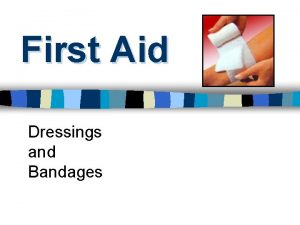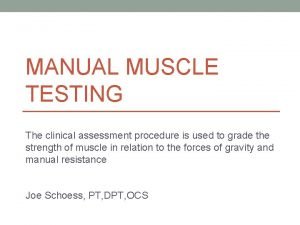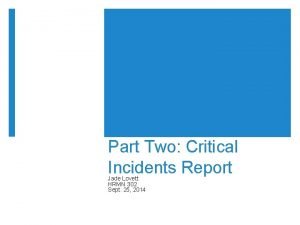A fluid handling assessment of foam dressings Lovett





- Slides: 5

A fluid handling assessment of foam dressings Lovett J. , Roberts S. , Stephenson C. Introduction: Fluid controlling capabilities of advanced wound dressings are of paramount importance when it comes to managing wound exudate. Poor wound exudate handling by a wound dressing can lead to fluid leakage from around the dressing or strike through, both of which can lead to soiled clothing and malodour; exacerbating patient social isolation. Additionally if the dressing is not capable of absorbing or transmitting wound fluid away from the wound or skin, then the consequences are generally tissue maceration, causing pain, delayed wound healing and infection. It is vital therefore that wound dressing fluid management data be made available to the clinician to allow them to choose the most appropriate dressing in relation to the fluid levels that are exuding from the wound. Aim: To assess the fluid handling performance of a selection of foam wound dressings (A, B, C, D)* in-vitro in order to gain an understanding of their exudate handling characteristics. *Dressing brand names: Dressing A - Kerra. Foam Gentle Border (Crawford Healthcare), Dressing B - Allevyn Gentle Border (Smith & Nephew), Dressing C - Aquacel Foam (Convatec), Dressing D - Mepilex Border (Mӧlnlycke Healthcare)

Method: Total absorptive capacity in an ionic solution (142 mmol sodium ions, 2. 5 mmol calcium ions). Weighed dressings were fully submerged in excess of solution A for 30 minutes at 37°C. Dressings were then reweighed. Total absorbency was determined by subtracting the dry dressing weight from the wet dressing weight. The test was repeated in triplicate. Simulated wound model (adaptation of the method described by Thomas & Fram 1). Weighed dressings were applied to a steel plate (heated to 37 o. C), which contained a fluid inlet port. On the steel plate, a 1 cm long channel allowed Solution A to be delivered to the dressing at a rate modelling that of a highly exuding wound; 2 ml/hr 2. An overflow beaker was placed underneath the model to capture any fluid not absorbed. A 500 g container of desiccant was placed on top of the dressing. After a period of 24 hours the dressing was removed and re-weighed. Subsequently, the saturated dressing was applied to a perforated surface and a 5 kg weight applied for 30 seconds and again weighed. Each measurement was undertaken in triplicate. Retention of fluid in the dressing was calculated as the weight after compression minus the wet dressing weight, and expressed as a percentage of the total fluid absorbed by the dressing. Fluid uptake was determined by inverting a test tube containing 10 ml of Solution A onto the wound contact surface of each dressing. The time taken for the dressing to fully absorb all of the fluid was recorded. This test was repeated in duplicate. 1. Thomas S, Fram P. The development of a novel technique for predicting the exudate handling properties of modern wound dressings. World Wide Wounds, 2001. 2. Dealey C, Cameron J, Arrowsmith M. A study comparing two objective methods of quantifying the production of wound exudate. J. Wound Care, 2006; 15(4)

Results: Graph one shows the total absorption of each of the four foam dressings tested. Dressing A achieved a superior absorption capacity than the other three dressings tested. Total Absorption (g) 120 100 80 60 40 20 0 Dressing A Dressing B Dressing C Dressing D Graph one – total absorption of Solution A by four foam dressings The results of the simulated wound model can be seen in Table one. Dressing A had a fluid retention of 99. 88% of Solution A and absorbed 40. 87 g. Each of the other dressings failed to absorb the total fluid delivered over 24 hours; therefore lost fluid to the overflow cup. Dressing A Dressing B Dressing C Dressing D Fluid fed in (ml) 48. 1 48. 0 48. 2 48. 0 Fluid absorbed (g) 40. 87 22. 57 19. 68 24. 14 Fluid not absorbed (g) 0. 00 1. 60 13. 79 11. 96 Fluid retained following compression (g) Fluid retained following compression (%) 40. 81 18. 31 17. 84 18. 60 99. 88% 85. 83% 92. 93% 81. 74% *Dressing brand names: Dressing A - Kerra. Foam Gentle Border (Crawford Healthcare) Dressing B - Allevyn Gentle Border (Smith & Nephew) Dressing C - Aquacel Foam (Convatec) Dressing D Mepilex Border (Mӧlnlycke Healthcare)

Graph two shows the rate of uptake of 10 ml of solution A by each of the four foam dressings. Note – Dressing B and Dressing C took longer than 90 minutes (5400 seconds) to absorb the fluid, after which time the experiment was stopped. 6000 Rate of uptake (seconds) 5000 4000 3000 2000 1000 0 Dressing A Dressing B Dressing C Dressing D Graph two – time taken for foam dressings to absorb 10 ml of Solution A *Dressing brand names: Dressing A - Kerra. Foam Gentle Border (Crawford Healthcare), Dressing B - Allevyn Gentle Border (Smith & Nephew), Dressing C - Aquacel Foam (Convatec), Dressing D - Mepilex Border (Mӧlnlycke Healthcare)

Graph three shows the fluid absorbed during the simulated wound model and the quantity retained following compression with a 5 kg weight. This modified fluid absorption/retention test provides a test that is more allied to the clinical situation in terms of delivering fluid at a clinically acceptable rate over a period of time. 45 Mass of Solution A (g) 40 35 30 Fluid absorbed (g) 25 20 Fluid retained following compression (g) 15 10 5 0 Dressing A Dressing B Dressing C Dressing D The results clearly show that Dressing A both absorbs and retains more fluid within the dressing than the comparators. In addition, the rate of fluid uptake by Dressing A was significantly faster than that of Dressing B and Dressing C. Graph three – fluid absorbed and retained following compression when tested using a simulated wound model Conclusion: The challenges of exudate management require a clear understanding of wound dressing capabilities; this study shows that Dressing A would be the dressing of choice in moderate to highly exuding wounds. *Dressing brand names: Dressing A - Kerra. Foam Gentle Border (Crawford Healthcare), Dressing B - Allevyn Gentle Border (Smith & Nephew), Dressing C - Aquacel Foam (Convatec), Dressing D - Mepilex Border (Mӧlnlycke Healthcare)







